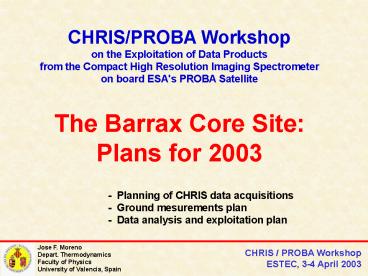Sin ttulo de diapositiva - PowerPoint PPT Presentation
1 / 15
Title:
Sin ttulo de diapositiva
Description:
from the Compact High Resolution Imaging Spectrometer. on board ESA's PROBA ... database of high. resolution images (Landsat, SPOT, etc.) time-series along 2003 ... – PowerPoint PPT presentation
Number of Views:792
Avg rating:3.0/5.0
Title: Sin ttulo de diapositiva
1
CHRIS/PROBA Workshop on the Exploitation of Data
Products from the Compact High Resolution Imaging
Spectrometer on board ESA's PROBA
Satellite The Barrax Core Site Plans for 2003
- Planning of CHRIS data acquisitions - Ground
mesurements plan - Data analysis and
exploitation plan
Jose F. Moreno Depart. Thermodynamics Faculty of
Physics University of Valencia, Spain
CHRIS / PROBA Workshop ESTEC, 3-4 April 2003
2
Barrax Core Site
STUDY AREA
vegetation map
soil map
3
Major on going activities in 2003
DEMETER (DEMonstration of Earth observation
Technologies in Routine irrigation advisory
services) European Commission contract
EVG1-CT-2002-00078, 12/2002-11/2005 (Energy,
Environment and Sustainable Development
Programme)
- database of high resolution images
(Landsat, SPOT, etc.) time-series along
2003 - intensive field campaigns - systematic
ground measurements (time series of
vegetation parameters)
4
area definition for satellite data coverage
5
Other on going activities in 2003
- Three ENVISAT projects on-going in 2003 using
Barrax as test site - ENVISAT AO
project MERIS / ASAR synergy -
ENVISAT AO poject AATSR data validation
- Development of MERIS bio/geo-physical
products - Vegetation Fluorescence
model validation - Meteosat Second Generation
(MSG) SEVIRI data products validation - ESA
TerraSAR campaigns - Fluorescence airborne
sensor campaigns (?) - SPECTRA campaigns (?) -
...
6
Ground radiometric measurements
Surface reflectance measurements - GER-3700
spectroradiometer - GER-3700 spectroradiometer
digital camera IFOV - ASD FR spectroradiometer -
reference calibration panels (3
Spectralon) Solar radiation measurements -
Optronic OL-754-PMT - Licor 1800 - Microtops
sunphotometer - CIMEL sunphotometer
7
Aerosols characterisation by means of ground
lidar Ground-based lidar from CIEMAT-Madrid,
Spain to be deployed in Barrax in coincidence
with PROBA overpass
NdYAG laser, l 532 nm Range 2 a 6 km
Vertical resolution 5 10 m Only possible
with adequate planning well in advance !!!
8
Planned vegetation measurements
LAI, fCover, biomass, height, chlorophyll,
etc. - A multitemporal intensive (weekly
measurements) in a reduced test site (part of
on-going EC project) - A multitemporal
extensive campaign covering around 200 fields
in an area of about 30 km wide (also part
of on-going EC project) - Specific CHRIS/PROBA
field campaigns - MERIS activities (validation)
- leaf/canopy model-validation activities
9
Best four periods for CHRIS/PROBA acquisitions
10
Temporal evolution of key vegetation parameters -
Barrax 2002
11
Temporal evolution of key vegetation parameters -
Barrax 2002 after normalisation
12
Mode of data acquisition
Rationale - fields are large enough (34 m
resolution is good) - most interest on spectral
data (62 spectral bands) - size of study area
adequate for Full Swath mode Conclusion
Mode 1 is the most adequate
- adequate for MERIS data validation -
adequate for SPECTRA studies (50 m
resolution)
13
CHRIS acquisitions
Four blocks of 15 images 60 images in total 3
sets of 5 angles per acquisition block (15
images per block) - almost simultaneous
-----gt full BRDF retrievals - large time
separation -------gt multitemporal
along-track BRDF
Optimum periods
for each acquisition block 28 April -
17 May 26 May - 15 June 15
July - 28 July 13 August - 2
September - adequacy for integration with other
parallel activities
14
Planned data analysis
Geometric registration - experience from
airborne data geocoding resampling of
multiangular/multiresolution data Atmospheric
correction - experience from airborne data
processing plus on-going activities for MERIS
processing Biophysical parameter retrievals -
experience from DAISEX campaings plus on-going
activities for SPECTRA Multitemporal study - by
using crop growth models and field data
15
Conclusions
- Barrax is still an interesting area for
CHRIS/PROBA - A large number of parallel
activities going on in the area along 2003
guarantee ground data, complementary
airborne/satellite measurements and adequate
CHRIS data analysis and exploitation with
available resources - A good scientific
programme can still be carried out in the
period April-September 2003 (optimum dates and
configurations have been identified)































